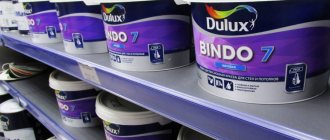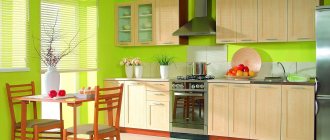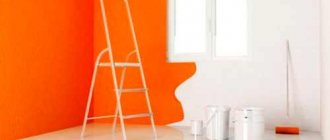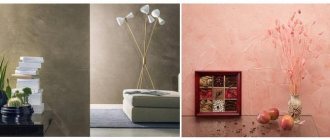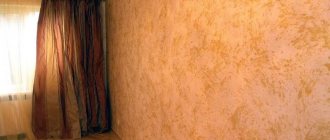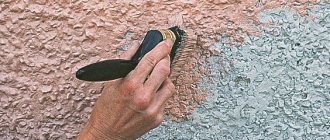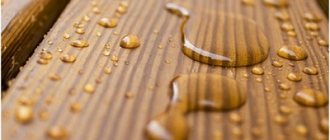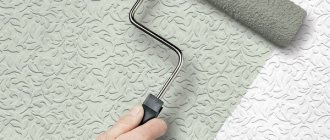How to update the appearance of your favorite apartment? How to finish the walls?
If the wallpaper has become boring for a long time, and decorative plaster is too expensive, painting is considered an alternative option. Moreover, a huge number of all kinds of coloring materials are now on sale. Many shades, varied structures, bold design options can radically transform your cozy nest.
Advantages and disadvantages of painting walls
Advantages of painting walls with paint:
- Ease of work. You don't have to hire a professional to paint your walls. Anyone can cope with this task if only they strictly follow the necessary instructions. It is convenient to paint in rooms with complex wall structures, the presence of protrusions, corners, etc.
- Possibility of implementing bold design solutions. If you have a good imagination, you can easily create unique patterns on your walls.
- ease of cleaning. Most painted surfaces can withstand wet cleaning, some with detergents.
- Durability of service. The service life of surfaces painted with good material is 10 – 20 years.
- Brightness and color saturation. Paints are available in a wide range of colors. With the help of additional coloring of the base compositions, unique colors are created.
- Lack of interest in this type of decoration among pets. A great option for cat and dog lovers. Pets do not scratch painted surfaces.
- A simple way to eliminate shortcomings. Stains from children's hands, scuffs near switches, dirt near the shoe department can be eliminated with a simple touch-up.
Flaws
Among the disadvantages of applying paint compositions to walls are:
- The need for careful preparation and cleaning of walls from “old” coatings.
- Ideal surface leveling before painting. No paint will hide cracks and cavities larger than 2 mm (the exception is the textured structure).
- Fading, poor vapor permeability, dust accumulation. These properties may appear when using certain types of cheap compounds.
- Careful execution of work, strict adherence to instructions. Otherwise, you can get an unexpected result: the visibility of brush marks, changes in shade, accumulation of streaks, omissions, etc.
Purpose of paints when repairing walls
Any interior contains elements finished with paint. These can be individual decorative details, ceilings, window frames, doorways and doors, as well as walls. For each described case, different types of paints can be used. Let us consider in more detail what compositions are used for painting walls, what properties they should have when used in residential premises.
General purpose of paint:
- Decorative finishing
. Creating a monochromatic or multi-colored surface can decorate any room, changing it beyond recognition. In this meaning, the paint can be selected according to color and texture, as well as the degree of gloss. Special paints allow you to eliminate minor irregularities and mask small cracks on the walls. - Protection of the treated surface
. The film formed after complete drying on the surface of the wall protects it from wear, moisture and sunlight. When special functional substances are included in the paint, it is possible to neutralize fungal spores and other dangerous microorganisms (antifungal, antibacterial effect). Some paints contain components that have an anti-corrosion effect.
How to choose wall paint?
Basic physical, technological and operational properties of paints and varnishes
To make the right choice in favor of one paint or another, you need to understand some of its beneficial properties:
- Colors and shades. The main characteristic in favor of choosing staining over other types of finishing. It is worth paying attention to the presence of exemplary shades, the possibility of coloring, and the presence of the necessary pigments.
- Thixotropy is the ability of coloring compounds to change viscosity when moving. When stirring, the fluidity increases, and in a standing position (on a brush, roller) the composition thickens. As a result, the material does not spread and consumption is reduced.
- Curvature - the property of creating a flat surface without gaps or sagging, is a mandatory criterion when calculating the amount of consumable compositions. To cover the walls with paint with good curvature, one or two layers will be required.
- Dullness. The surface coated with paints can be matte or glossy. Matte finishes look calmer, but accumulate more dust. Glossy compounds shine and repel moisture.
- Texture. After painting, the wall may look smooth or embossed with the presence of grains of sand, grains, and fibers. Such details can create a three-dimensional structure and hide surface imperfections.
- Cleaning properties. Some paints and varnishes are only suitable for dry rooms. They lose their properties with one-time wet cleaning. Others are resistant to deformation and are easy to clean with detergents.
- Safety for health and the environment. Good paint should not release harmful substances into the air, cause allergies, or be a fire hazard.
- Drying time. The time required for the paint to dry completely. Necessary when applying a subsequent ball of coloring materials or settling residents.
Types of paints
Once the key properties of paints and varnishes have been determined, it is worth understanding the variety of types of paints and varnishes.
Types of wall paint:
- Oily. Popular in the old days, but almost never used for wall decoration in apartments now. They are made on the basis of mineral and vegetable oils, which oxidize in air. An oxide film is created on the surface, which does not allow the surface to “breathe”. Over time, M.k. fade and cracks appear on the surface. M.k. more often used for outdoor work.
- Alkyd. In addition to oils, their basis includes acidic substances of organic nature. They dry out quickly. Painted surfaces are distinguished by rich colors. The disadvantage of alkyd paints is the unpleasant odor released during painting and after drying and a high fire hazard. Experts recommend using alkyd paints and varnishes to coat radiators, pipes, and doorways.
- Silicate. They are made on the basis of alkaline mineral substances (“liquid glass”). They withstand abrasive loads, high humidity, and prevent the development of fungus and mold. Well suited for damp areas and kitchen walls. The main disadvantage of silicate-type compositions is incompatibility with other types of paints and varnishes. It will not be possible to renew the surface after using another paint, nor will it be possible to apply a different type of composition on top. The same applies to pigments. Coloring is possible only with mineral-based pigments, and there are not many of them on sale.
- Water soluble. This is a family of the most popular paintwork materials. It is among them that you should choose paints for covering the walls in your apartment.
The solvent for them is water, in which all the necessary components are dissolved.
Water-soluble paints
| Paint type | The basis | Properties | The main purpose |
| Acrylic | Acrylic resins | Coating strength, UV resistance, water resistance, corrosion protection | Due to the high price, it is used for decoration and decoration on the wall. |
| Latex | Latex | Quick-drying, washable, waterproof. Capable of masking minor defects, a variety of bright colors | For painting plastered surfaces, drywall, wallpaper for painting |
| Water-based | Emulsions of dyes with water | Many colors, easy to apply, can hide minor defects, not waterproof, accumulates dust, short service life | For painting plastered surfaces, drywall, wallpaper for painting (inexpensive method of cosmetic repairs) |
| Water-dispersed | Moisture-resistant mixture | Washing, easy to color, have high vapor permeability, resistance to low temperatures and damage | For painting and decorating wooden and concrete surfaces. |
| Butadiene-styrene | Synthetic rubber | Resistance to moisture and abrasions, fading under the influence of ultraviolet radiation | For painting walls and ceilings |
| Silicone | Emulsion of water with dyes | High curvature, a combination of the advantages of all previous types | The best paint for walls in an apartment |
| Polyurethane | Polyurethane resins | Service life 20 years, resistance to vibration, moisture, light and frequent cleaning | Expensive material with universal action. The components must be mixed before use. |
Main characteristics and properties of paints
When choosing paint for residential premises, you need to pay attention to the harmlessness and environmental friendliness of the material. Some formulations may contain components that are harmful to health. Harmful effects can occur not only during the painting process, but also after complete drying during the entire period of operation. The activity of secretions can be influenced by microclimate, temperature, and humidity levels.
Different types of coloring materials have different resistance to various types of damage. The durability and service life of the coating depends on the level of wear resistance.
Caring for a painted wall may vary depending on the composition. Some materials cannot withstand moisture, so such walls will have to be cleaned using dry methods. There are also indelible paints - they can be cleaned with water, but stains may not be removed at all, or it will be very difficult.
There is also a third type of paint and varnish composition - washable paint. It is able to repel dirt, and the wall can also be washed with soap or alkaline solutions. Along with these compositions, there are products on sale with low operational load - they are intended for dry rooms and do not withstand exposure to steam, cigarette smoke, and fats.
An important characteristic is hiding power. This property allows you to cover the color of the wall being treated. High hiding power means that 2-3 layers of material will easily cover even basic contrasting colors.
Resistance to light and sunlight is important. For illuminated rooms, it is better to choose a composition that can withstand exposure to direct sunlight and ultraviolet radiation. If the composition has poor light resistance, then after a certain time the shade will lose its saturation and fade. This should be kept in mind before choosing a paint material.
The consumption of the composition depends on the covering power. When purchasing, you should pay attention to expensive materials - they are ultimately much more economical than cheap paints. An expensive color mixture has high hiding power and often it is enough to apply one layer. But today different paints can be used for walls in an apartment - how to choose the best option?
What paint to paint the walls in the apartment?
What paint to choose for the walls?
For rooms with high humidity and risk of fungal infection, use waterproof alkyd or polyurethane paints for kitchen and bathroom walls. Latex or acrylic water-based emulsions are also suitable.
For bedrooms, choose matte options, pastel colors or combinations thereof.
Decorated patterns, combinations of matte and glossy surfaces of the same color, highlighting corners and niches with contrasting shades will look good in living rooms.
For children's rooms, bright wall paints with a glossy surface, easy to clean and safe for health, are suitable. Latex and silicone water-based emulsions will cope well with these tasks.
Hallways are painted with dark glossy compounds in the lower part and light matte ones in the upper part. Any type of water-based emulsion is suitable, depending on the surface of the coating.
Decorative textured compositions will perfectly brighten up uneven corners and walls.
Important! Use only paints and varnishes intended for painting indoor walls. Ceiling, floor, facade and even universal paints may not have the necessary properties, thereby worsening the quality of the repair and your expectations.
The best painting materials for apartment walls today are latex and silicone water-based compositions.
Which manufacturer should you prefer?
Paintwork materials from numerous manufacturers are on sale. To paint the walls in an apartment, it is better to choose compositions from well-known brands. Moreover, most of these companies also produce inexpensive ranges of paints and varnishes.
Finnish paint compositions have shown themselves to work well (for example, acrylic compositions “Euro-2” and “Euro-7”).
Excellent results are obtained by painting walls with German compositions.
Compositions from manufacturing companies “Superweiss” and “Wandfarbe” are very popular among craftsmen.
Paintwork materials of the brands “Mokke”, “Snezhka”, etc. are often used.
Among domestic manufacturers, coating materials for interior walls, Admiral, Nevskie Krasov, Yaroslavskie Krasov, etc. are popular. The products of these companies are of good quality and reasonable prices.
In any case, consult with professionals before purchasing new paint.
How to choose the right paint color?
The selection of colors is an individual matter and there are no clear rules.
When choosing a color palette, we are guided by the following principles:
- in darkened rooms use light colors;
- in rooms with bright sunlight, it is preferable to paint the walls with UV-resistant paints. Shades of yellow, brown, orange, and gray are permanent colors. Purple and blue tones fade quickly;
- For bedrooms, calm colors are preferable: pink, blue, light green;
- For children's and living rooms, bright combinations of several types of paints on the wall are suitable.
For the ideal selection of color palette compatibility, designers created tables. They contain a color scheme that will be combined in one room. Such tables will help create a harmonious interior.
How to make the right choice?
Interior paints for walls are selected according to the correspondence of their properties to the purpose, walls, and microclimate of the room. For kitchens or bathrooms, alkyd and polyurethane materials are chosen. Latex and acrylic dyes, which contain agents against the formation of fungus and mold, are applicable in rooms with high levels of humidity.
The main characteristics when choosing a coloring material are service life and operational stability. These factors are important for hallways. Latex-acrylic materials are suitable for these rooms. For bedrooms, water-based paints are ideal to create matte surfaces.
These are not all types of dyes. There are also polymer and adhesive materials. It is difficult to say which wall paint is better - the choice depends on a lot of factors. How to choose paint for walls - you need to take into account the characteristics, texture of the wall, colors and make a choice based on this.
Expert advice (2 videos)
Paints from different manufacturers (45 photos)
Applying paint
Features of preparing the base
An important stage of painting is the preliminary preparation of the walls. The quality of the work performed directly determines the result and durability of the finish.
Stages:
- the walls are cleaned of peeling coatings, debris and dust; Important! Before painting walls with compounds that are incompatible in chemical properties, the previous paint must be completely removed.
- the surface is leveled with finishing plaster. Large cavities are covered with starting compounds or cement. Protruding traces of rust are cleaned and covered with glue;
- sand the walls with a float;
- clean the dust with a rag;
- a ball of primer is applied, which increases the contact of the surface with the paintwork material and saves the consumption of the latter.
Materials for painting walls
To paint walls, brushes and rollers of different sizes and structures are used. Some paintwork materials can be sprayed with a spray gun.
For decorative finishing, stencils, tapes, tape, etc. are used. How the material you choose is applied is usually indicated on the can of paintwork.
How much paint will be needed?
The paint consumption per 1 m2 of area is written on the container with the material. But, when calculating the amount of paintwork materials, the curvature and surface properties should be taken into account. Fresh plaster or dark balls of previous finishing materials always require additional consumption. On the contrary, primed drywall or pasted wallpaper reduces the amount of material required to a reasonable extent.
The consumption of textured paint is greater than that of smooth paint.
Advice! When coloring, be sure to stock up on an “extra” jar, since in the future it can be very difficult to guess the shade.
Paints for bathrooms, kitchens and hallways
For sanitary premises and kitchens, it is recommended to choose a moisture-resistant coating - for example, silicate, latex or acrylic mixtures would be a good option. Moreover, it is advisable to use those that contain antifungal components.
For a kitchen, it is important that walls painted with paint selected according to this principle can be easily washed from grease stains. Acrylic compounds are also suitable for this.
The walls in the hallway and corridor should be painted with a composition that is resistant to various mechanical influences. Acrylic-latex types are considered a good option. But if wall panels are used for decoration in a room, then they can be treated with alkyd compounds.
Alkyd compositions
Many people confuse varieties such as oil and alkyd. But the latter are a separate group of materials. They use alkyd resins as a binder, which are obtained from vegetable oils, including linseed and soybean.
But they are united by common shortcomings. While alkyd products are practical and abrasion resistant, they are not durable finishes. When the mixture dries, it emits an unpleasant odor.
Silicate paints are used for painting plastered walls in the kitchen, bathroom and toilet.
Paints based on liquid glass silicates
Silicate paints can be used for the home, but they are only suitable for painting mineral surfaces, which requires the use of appropriate plaster. The polymer base does not have good adhesion to compositions based on liquid glass silicates.
Silicate options are considered a good choice for rooms with high humidity. They contain antibacterial components, which provide protection against fungus and mold. At the same time, they have high vapor permeability rates, the walls underneath them “breathe,” which prolongs the service life of the base.
What paint is best to paint walls?
There is no clear answer to this question. It all depends on the specific room, humidity conditions, lighting, surface properties and the surrounding interior.
An important factor is the money issue. Good paint for interior work is no less expensive than high-quality wallpaper. The result of the repair will definitely be completely new. And the ease of implementation for an inexperienced person is a relative matter. For an impeccable result, it is better to use the designer’s advice. Plain walls may need to be decorated with paintings, shelves, and vases.
But, if you work hard, painting the walls can literally “transform” your apartment into a completely new home!
What is better: domestic paint for walls or foreign?
At the stage of purchasing such products, you often have to face the agony of choice, since the assortment is simply huge. When you go to any store, you will be offered goods from domestic manufacturers and imported analogues. The difference in cost can be quite large, so if you are interested in maximum savings, then it makes sense to support a domestic manufacturer.
As for quality, it can be good or bad everywhere, and you need to first study reviews of the products of a particular manufacturer. You need to be careful and beware of counterfeits, of which there are many on the market for these products.
If you know that the product is branded and from a well-known company, then you should not buy it at half the price, since there is a possibility that it is counterfeit. There are often cases when consumers decide to save as much as possible and then regret it. The poor-quality coating quickly lost its original appearance, and the walls had to be decorated and repainted again.
Latex paints
These compositions are one of the varieties of water-soluble mixtures, the main feature of which lies in increased wear resistance. Important: If you intend to paint the walls so that they remain in their original form for a long time, then in this case it is advisable to give preference to this particular product. In the future, if the need arises, you can safely wash the walls and not worry at all that the decorative coating will be damaged in any way during such care. It is not at all necessary to apply a thick layer of this material, since a thin layer will be quite enough. Using this product you can even paint wallpaper that was initially intended for further painting.
Walls covered with latex paint can be washed. There are not only glossy, but also matte paints of different colors on sale, which will allow you to realize any design idea. Such mixtures are often used by designers, as they have an excellent cost-quality ratio, and also provide the necessary opportunity to implement bold and interesting solutions. In general, at the stage of choosing such products, you should give preference to those products that have the appropriate markings, indicating the possibility of painting the walls. As for ceiling paints, they have completely different qualities.
First group: water-based paints
Emulsion paints
Emulsion paints are diluted with water (do not dissolve), their binder base and coloring particles are distributed in an aqueous environment, forming a stable emulsion. After drying, they are not washed off with water. But they are easy to wash off your hands and tools (until the material dries). Emulsion paints are economical, environmentally friendly and fireproof. Fits well on almost any surface. Metal coatings must first be primed to avoid corrosion. Emulsion paints cannot be applied to surfaces previously painted with glossy paints or adhesive paints. The same applies to varnished surfaces. In turn, after emulsion paints, you can use any paints and enamels. Emulsion paints dry quickly and do not have a strong unpleasant odor. They are alkaline resistant.
Emulsion paints are divided into: water-based, acrylic, polyvinyl acetate (PVA), latex, water-dispersion and silicone. Many people believe that water-based
and water-dispersion paints
are the same thing. All of them do not have the ability to peel off, are permeable to air and water vapor, that is, they “breathe”. Suitable for rooms with high humidity, not frost-resistant, but retain their color for a long time (read a detailed analysis of how to choose the color of a room).
But there are still differences. Matte water-based paints gradually wash off over time, while water-dispersion paints are moisture resistant, which means they are suitable for repeated washing. In addition, water-dispersion paints are mainly white, while water-based paints are striking in a variety of colors. Water-dispersion paints cannot be applied at temperatures below +5°C.
In addition, there are water-based paints designed to create three-dimensional effects - textured paints, which are also called structural paints. They can be used to successfully decorate surfaces. Such coatings are also highly durable. They can play the role of reinforcement to protect the surface from cracks. Often textured paints are called decorative plasters or textured plasters.
Textured plasters
Effect "Bark Beetle"
Fur coat effect
Pebble
Marble chips
The binding element for acrylic paints is acrylic resins. These paints are highly elastic (adapted to the specific characteristics of wood) and have great strength. High-quality acrylic paints can cover hairline cracks up to 0.5 mm. It's a pity that they are quite expensive. Their cheaper counterparts are made on the basis of acrylic copolymers. Acrylic paints are frost-resistant, but only after complete drying. They have low gas permeability, and therefore can provide good protection against corrosion, for example, reinforced concrete. Suitable for alkaline substrates, but they can be applied to fresh plaster no earlier than after a month. The reason is the low gas permeability: carbon dioxide is involved in the hardening process of the plaster, and this process is quite long.
Acrylic paints
Acrylic paints are not suitable for buildings with damp walls. These paints are perfectly tinted and resistant to ultraviolet radiation, retaining color perfectly. They also combine water repellency and vapor permeability. They have the highest mechanical resistance.
Latex paints
Latex paints are the most expensive of the emulsion paints. They are made with the addition of latex. This gives a strong water-repellent effect, which means you can wash the surface as much as you want. They are able to heal hairline cracks up to 1 mm. Latex paints are used on different surfaces: structured wallpaper, walls (concrete, plaster, brick, plasterboard), ceilings. Dries in 20-60 minutes. But their light resistance is lower than that of emulsion acrylic paints and PVA.
Polyvinyl acetate (PVA) paints
Polyvinyl acetate (PVA) paints, unlike latex ones, are the most budget-friendly. However, they also have low water resistance, and with regular washing, the coating gradually washes off with water. The paint is environmentally friendly, highly resistant to light, oils and fats, and is suitable for indoor use, especially for painting ceilings. By the way, read the article on how to choose paint for the ceiling.
Silicone paints
Here, emulsified silicone resins serve as the binding element. Silicone resins are sometimes even added to acrylic paints. Silicone paints dry to form a water-repellent surface, but are highly permeable to air and water vapor. They have high elasticity and are able to bridge hairline cracks up to 2 mm. Silicone paints can be applied to fresh plaster after 48 hours (and not after 30 days like acrylic paints). Silicone paints can be used on all types of mineral surfaces.
They are compatible with acrylic latex and mineral paints. They can even be applied to old silicate paint. Silicone coatings are resistant to stains and also prevent the development of microorganisms. Their only drawback is their high cost. Therefore, they are used mainly for decoration, especially if they want to emphasize the prestige of the building.
What is interior paint
This category includes many decorative, protective and specialized compounds for interior work. They are divided into:
- moisture resistant;
- conservation;
- heat resistant;
- fire retardant.
Interior paint is applied to plastered surfaces, untreated concrete, wood, metal, plastic or rubber. Manufacturers obtain the desired colors by adding pigments. The properties of the product are determined by the base, the role of which is played by synthetic or organic resins, oils, and fine substances.
For interior decoration, only paints that do not contain toxic components are used.
Features of acrylic paints
This product is invariably made on the basis of acrylic resins, which lead to the appearance of a characteristic film after the mixture hardens. Among the advantages of such a coating, the first thing to note is its high resistance to many external influences. Such compositions can be safely used even in rooms where there is constant high humidity.
The paint requires a minimum amount of time to harden, so the room can be put into operation in the shortest possible time. Acrylic paint dries very quickly. Interesting fact: It is noteworthy that you can even purchase textured acrylic-based paints, which allows you to implement interesting design ideas. The price-quality ratio for products in this category is also at a high level.
Choosing interior paint
The composition is chosen taking into account which element of the interior it will be applied to. There are paints for walls or ceilings. If it is necessary to paint all surfaces in one tone, it is recommended to choose universal options.
For walls
A water-based product is suitable for decorating plastered surfaces. However, when treating bathroom walls, it is recommended to use silicate or alkyd varieties. These types of paints resist moisture better.
For the ceiling
The type of composition is not important, but thixotropic agents characterized by a thick texture make coloring more convenient. When stirred, the paint liquefies; after stopping the procedure, the solution acquires the consistency of sour cream.
The product is convenient for working with horizontal surfaces; it is not advisable to use it for decorating walls. Thixotropic paint requires careful distribution over the substrate.
It is better not to use ceiling paint for painting walls.
Third group: silicate paints
Silicate paints
Silicate paints are made on the basis of liquid glass; they can be classified as mineral. This is one of the best ways to protect the facade. Characteristics of silicate paints: vapor and air permeability, increased resistance to temperature changes and ultraviolet radiation, friability, poor reaction to water. It is worth considering that silicate paints are not only stable, they are practically indelible. Silicate paints are diluted with water and contain alkali - protect your eyes and skin. They cannot be applied to surfaces previously painted with acrylic or alkyd paints, or applied to glass, ceramic, stone, or metal surfaces. But they are suitable for alkaline surfaces, for example, plasters. The primer before painting should also be silicate.
Silicate paints cannot protect walls from atmospheric moisture. During heavy rainfall, water lingers in the walls, albeit briefly. However, if the foundation is poorly waterproofed, they are very useful if the humidity in the walls is higher than atmospheric. The color range of silicate paints is limited due to the alkali contained in the composition.
What paint parameters should you pay special attention to?
When choosing products for painting interior surfaces, the characteristics of wall paints should first be considered. Particular attention should be paid to such indicators as: • environmental friendliness; • wear resistance; • care requirements; • hiding power; • time until complete drying; • durability; • consumption. When it comes to home renovation, the harmlessness of the materials used plays a very important role. Not everyone knows that many coloring compounds can be harmful to human health even after complete drying.
Paints that are unsuitable for use at elevated temperatures and high humidity emit large amounts of toxic substances, which should be taken into account when using them. The wear resistance and care of each composition are also different. Some coatings can be rubbed and washed using chemicals, while others do not accept contact with water at all. Taking into account the specifics of the room being finished, you should choose the most suitable option.
The hiding power indicator indicates the ability of the composition to cover the previous color. The higher its value, the fewer layers will need to be used until the old shade is completely painted over. For rooms located on the sunny side, the lightfastness of the paint is very important. To prevent painted walls from losing their color saturation over time, it is recommended to choose a coating that is resistant to ultraviolet radiation for such rooms.
The choice of paint depends on the surface to be painted
Before choosing a product, it is recommended to consider the area you plan to paint.
The solution that should be used for this depends on its details and the result you want to get. To select a solution, base it on the following indicators:
- Surface quality. It can be different: concrete, brick, drywall, plaster, putty, or wallpaper. For wallpaper, choose a separate series of paints and varnishes.
- Temperature characteristics of the room. Consider whether the living area will be exposed to sudden temperature changes, as not all coatings can withstand this.
- Purpose of the room. For a children's room, choose coatings that do not contain toxic components. And for bathrooms, the paint should be waterproof. For the corridor, choose materials that can be easily washed with plain water or solution.
- Interior. To choose which paint is best for repairing walls and ceilings, take into account its characteristics - whether it fills in the unevenness of the wall or emphasizes them. Consider the number of colors in the series.
Choosing paint for renovation is not difficult, the main thing is to study all the options, choosing it according to the criteria. An important criterion is price, but not all coatings have a low price.
Highlighting individual details in the interior
When planning to add something original and interesting to your design, it is important to know how to do it correctly. Using bright colors when painting, you can create geometric shapes, but carefully and in moderation. This decor will help highlight a specific functional area in the room.
Patterns are used as an original solution. Wall paintings can be either bright and rich or barely noticeable. The choice depends on the wishes of the owner and the purpose of the room. When creating a unique space, it is important to remember that in one room you should not use combinations of more than four colors, otherwise the atmosphere will become heavy and will depress, rather than relax or delight.
Options for patterns that can be used on a painted wall are: zigzag, wave, color block, stripe, diamond, a combination of gloss and matte structure.
Zigzag is applied to a wall with pastel shades and creates an accent on it. It is best to decorate the space near the sofa or armchairs this way. According to legends, if you place a zigzag vertically, you can attract great financial success, and horizontally, it will help in love affairs.
The wave can also be used as an accent option on one wall. For it, they choose a color palette of the same color scheme, but in different shades. The direction of application can be different, as well as the thickness of the smooth lines themselves. You can apply waves using a brush or roller, having previously outlined the contours with a simple pencil.
Color blocks are used for playrooms because they help create a dynamic atmosphere in the room. If you create such a design in the living room or dining room, you need to use pastel shades.
Stripes are also an interesting technique for decorating a room. Wide horizontal ones visually make the ceiling lower, and narrow horizontal ones make the ceiling higher. It is important to choose the right color scheme for them. Bright shades are suitable for the kitchen and living room, and a little calmer for the nursery.
Diamonds in decoration are used if there is a desire to free the room as much as possible from furniture and excess decoration. You can apply this pattern in the bedroom, in the nursery, and in the kitchen.
By alternating shiny and matte textures, you can achieve a bright effect, while at the same time the room will have comfort and warmth.
Several options for good paints for wall decoration
Having understood the basic characteristics of paintwork materials and decided on the desired type of material, it is important to choose a quality product. At the same time, we must not forget that saving on paint is not always justified, since finishing work is usually not carried out very often and every owner of the premises wants the interior to look attractive for as long as possible.
Dulux Professional Diamond
The water-dispersion composition, which has a matte texture after drying, is characterized by high resistance to wear, excellent hiding power, the ability to mask defects and the almost complete absence of a pungent odor. The paint can be applied to mineral substrates, wood, drywall and wallpaper. It tolerates wet cleaning very well, is elastic, strong and durable (serves up to 25 years without loss of aesthetic qualities). The material is applied in 2 layers. Drying time for each is only 4 hours. One liter of paint is enough to finish 16 sq.m. surface (1 layer).
Dufa Superweiss RD4
The coating is intended for finishing any premises, including those where children and the sick are located. It is environmentally friendly and resistant to abrasion (withstands up to 3000 cycles), is applied without streaks, and has no odor. After drying, a dazzling white (if no dye is added) matte surface is formed. The paint can be used to decorate concrete, gypsum and plastered substrates, as well as applied to wallpaper with a rough texture.
For painting 10 sq.m. the surface requires about a liter of composition. It is applied while standing. Drying time for the first one is 4 hours.
The disadvantage of the material is the lack of possibility of tinting in dark shades.
Blanc Perfection 3V3
Latex paint is intended for interior work. It is applied to mineral bases, wood and wallpaper. The coating contains natural marble, which helps preserve color for at least 10 years. Surfaces decorated with this coating can be washed using mild chemicals. The paint has good hiding power and is able to mask minor flaws in the base. It can be used to decorate rooms with moderate humidity levels.
The material is applied in one layer. It dries in 6 hours, but gains final strength within a month. For finishing 12 sq.m. 1 liter of paint is required.
Essence Flat Interior Wall Paint Acrylic Latex
American coating (belongs to the category of “new wall paints” on our market)
can be used for painting wood, plaster, primed metal, concrete and other substrates in premises of any purpose. It is environmentally friendly, has good hiding power, and is not susceptible to peeling, wear and abrasion. There is a possibility of tinting even in the most saturated colors.
Important! Interestingly, if any stain appears that cannot be removed, it is possible to tint only the dirty area and this place will not be visible.
The paint is usually applied in 2 layers. After the first staining, you should wait 4 hours. The consumption of the composition is 3.8 l (can)/38…42 sq.m.
Clavel EE Arabesco
To conclude the review, I would like to talk about an interesting product that stands out from paint and varnish materials intended for decorating walls with its interesting texture.
Using various tools and devices, designers can create a smooth coating on the base or achieve a textured optical effect that imitates the texture of silk fabric, and its shade can change depending on the lighting in the room and viewing angle. Walls decorated with such paints can be washed, but without chemicals containing abrasive inclusions. You can increase resistance to moisture using a layer of varnish.
The paint dries completely in 25…36 hours. Its consumption is 1.5 kg/10 sq.m. Finishing work can be carried out at temperatures of +5…+35 degrees.
For those who are interested in washable paints for walls in an apartment with a silk effect: photo price, options for interior design using this material and a price list for it are offered.
The approximate cost of coverage is given in the table:
Such textured wall paints with effects that imitate different materials are in high demand today among leading designers.
Composition of paints
Most paint and varnish materials, which include not only varnishes and paints, but enamels, primers, and putties, are made according to a single component scheme. They must contain:
- film formers
or binders, that is, the material that leads to the formation of a film on the surface; - pigment
, which gives the material its original color; - filler
, which saves pigment and gives the product physical properties, such as strength, shine, application properties; - solvents
and special
additives
- fire-resistant defoamer, fungicidal substances that protect the material from mold and fungi.
The level of the product itself directly depends on how well the components are selected and mixed. The paint of a self-respecting manufacturer contains from 8 to 20 components. It should be noted that good components are quite expensive for manufacturers, so they are forced to keep prices quite high.
Film former value
– bind all components of the paint and adhere it to the substrate.
The main characteristics of paint, its durability and adhesion to the substrate depend, first of all, on the film former or, more simply, on the binder. The binder affects the durability, service life of the coating under different operating conditions, gloss and drying time, as well as painting properties .
To improve the adhesion, elasticity and other properties of polymer materials, special functional groups are introduced into the composition of the polymer film. The latter method is implemented either through copolymerization of the binder, or by introducing additives during the production of the paint itself. Thus, the copolymer
synthetic resin is a polymer whose macromolecules include various monomer units, which makes it possible to control the performance properties of polymers over a wide range.
By choosing the second component wisely, you can, for example, reduce the cost of the dispersion without compromising its consumer properties. This applies primarily to paints based on styrene acrylates, vinyl acrylates and vinyl acetates. The term terpolymer is also used to name a polymer made from three monomers.
According to the chemical nature of the binder, all paints are divided into the following main types: oil, alkyd, epoxy, emulsion, silicate.
Pigments
are fine-grained dyes that are “responsible” for the hiding power and color of the paint. Colored fillers are usually: flock particles, chips, natural and tinted stone chips or quartz sand, water-insoluble pigmented particles with colored dyes. Color pigments are traditionally divided into organic and inorganic.
A filler is a targeted additive. Natural inorganic fillers used for paints and varnishes are obtained by grinding, enrichment, and heat treatment of rocks and minerals. Fillers for paints and varnishes can serve as:
- kaolin (clay);
- microcalcite (ground marble, crystalline calcium carbonate)
- talc (microtalc, technical talc)
- chalk, mica, etc.
Thus, when talc, whose particles have a flat shape, is introduced into the system, the material is not only strengthened, but also its weather resistance increases. Ground mica improves heat resistance and prevents film cracking at high temperatures.
Conventionally, solvents can be divided into solvents
and thinners.
What is the fundamental difference? The solvent dissolves the binder and at the same time reduces the viscosity, that is, it increases the fluidity of the paint. The thinner only reduces the viscosity. The manufacturer is required to indicate the solvent suitable for this type of paint. Based on the type of solvent, paints and varnishes are classified into two classes: water-dispersible and organic-soluble.
To improve the technological and performance characteristics of paints, various additives
. These additives (stabilizers, emulsifiers, antiseptics, fungicidal additives, etc.) are contained in paints in very small quantities, but they can decisively improve certain properties of the coating. In addition, their cost significantly affects the price of the final product.
Pros and cons of painting walls
Like any material for decorating a living space, paints have their advantages and disadvantages.
Positive properties:
- Preliminary surface treatment . This stage of work involves treating the wall with antiseptics and primers that can destroy any fungi and mold. If the process proceeds correctly, then in the end any cracks and chips on the surface will be removed, which means that there will no longer be places for the development of various kinds of microorganisms.
- Speed of work in case of re-coating . If the wall is already painted and there is a need to refresh the color, then a new layer is applied and the work can be considered complete. It is important to thoroughly inspect the surface for unevenness or cracks, which must be dealt with before new repairs.
- Easy to clean the coating . Painted walls are easy to clean, making their maintenance simple and convenient. Any dust, dirt and other contaminants can be quickly removed without damaging the coating.
- Safety with pets. If pets can scratch the wallpaper that was so carefully pasted during the renovation, then the paint on the walls will not interest them at all. Painted surfaces will remain untouched for the entire service life.
- The variety of paint options allows you not to limit your imagination and imagination, creating original design solutions using different textures, colors and shades.
There are also a number of disadvantages in paint, which are important to mention before carrying out repairs in the room. The disadvantages include:
- Long work to prepare the surface for applying paint. It must have an absolutely even appearance so that after painting you can get the desired result.
- Difficulty of the process for a beginner. If the work is to be done by a non-professional, then the first time it may not be possible to do everything correctly, which means that effort and materials will be wasted, and the result will leave much to be desired. In this case, only the services of a real master, which cost a lot of money, will help out.
- Regular care of painted surfaces. The walls of the living room need to be wiped regularly to prevent dirt and dust from accumulating on the surface, which will spoil it. The use of glossy helmets can only help a little in this situation.
- Low impact resistance . A painted wall cannot withstand the influence of external factors; the outer layer may peel off and the surface will not look aesthetically pleasing.
- Expensive design. If you want to make a drawing on the wall, then this is a job for real professionals who can accurately and beautifully realize all your ideas. However, you will have to pay a lot of money for such delights.
- Modern paint is environmentally friendly , so it can even be used in a nursery.
